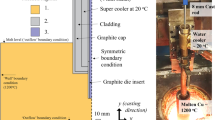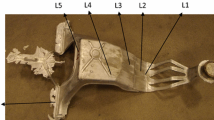Abstract
Zinc die casting alloys show varying material properties over the thickness in their final solid state, which causes a change in the mechanical response for specimens with different thicknesses. In this article, we propose a modeling concept to account for the varying porosity in the constitutive modeling. The material properties are effectively incorporated by combining a partial differential equation describing the distribution of the pores by a structural parameter with the Mori–Tanaka approach for linear elasticity. The distribution of the porosity is determined by polished cut images, for which the procedure is explained in detail. Finite element simulations of the coupled system incorporating the thickness dependence show the applicability of this approach.





















Similar content being viewed by others
References
Buffiere JY, Savelli S, Jouneau P, Maire E, Fougeres R (2001) Experimental study of porosity and its relation to fatigue mechanisms of model Al–Si7–Mg0.3 cast Al alloys. Mater Sci Eng 316:115–126
Diebels S, Steeb H (2002) The size effect in foams and its theoretical and numerical investigation. Proc R Soc Lond 458:2869–2883
Dippel B, Johlitz M, Lion A (2014) Ageing of polymer bonds: a coupled chemomechanical modelling approach. Contin Mech Thermodyn 26:247–257
Erbts P, Hartmann S, Düster A (2015) A partitioned solution approach for electro-thermo-mechanical problems. Arch Appl Mech 85:1075–1101
Gelfi M, Bontempi E, Pola A, Roberti R, Rollez D, Depero LE (2004) Microstructural and mechanical properties of zinc die casting. Adv Eng Mater 6:818–822
Gross D, Seelig T (2011) Bruchmechanik: Mit einer Einführung in die Mikromechanik (German edn). Springer
Gutman E, Unigovski Y, Levkovitch M, Koren Z (1998) Influence of porosity and casting conditions on creep of die-cast Mg alloy. J Mater Sci Lett 17:1787–1789
Hughes TJR (1987) The finite element method. Prentice-Hall, Englewood Cliffs
IZA (2016) Zinc diecasting alloys—mechanical properties. The International Zinc Association www.zinc.org
Johlitz M, Diebels S, Jan B, Steeb H, Wulff P (2008a) Size effects in polyurethane bonds: experiments, modelling and parameter identification. J Mater Sci 43:4768–4779
Johlitz M, Steeb H, Jänicke R, Diebels S (2008b) Effective properties and size effects in filled polymers. GAMM-Mitt
Klusemann B, Böhm HJ, Svendsen B (2012) Homogenization methods for multi-phase elastic composites with non-elliptical reinforcements: comparisons and benchmarks. Eur J Mech A Solids 34:21–37
Leis W, Kallien LH (2011) Ageing of zinc alloys. Int Foundry Res 64(1):2–23
Mori T, Tanaka K (1973) Average stress in matrix and average elastic energy of materials with misfitting inclusions. Acta Metall 21:571–574
Nemat-Nasser S, Hori M (1993) Micromechanics: overall properties of heterogeneous materials. North-Holland Series in Applied Mathematics and Mechanics, vol. 37. Academic Press, Elsevier
Rothe S, Erbts P, Düster A, Hartmann S (2015) Monolithic and partitioned coupling schemes for thermo-viscoplasticity. Comput Methods Appl Mech Eng 293:375–410
Steeb H, Diebels S (2004) Modeling thin films applying an extended continuum theory based on scalar-valued order parameter. Part I: isothermal case. Int J Solids Struct 41:5071–5085
Svendsen B (1999) On the thermodynamics of thermoelastic materials with additional scalar degrees of freedom. Contin Mech Thermodyn 4:247–262
Wriggers P (2001) Nichtlineare Finite-Elemente Methoden. Springer, Berlin
ZD (2016) Zinc-diecasting www.zinc-diecasting.info
Zuh H, Zbib MH, Aifantis EC (1997) Strain gradients and continuum modeling of size effect in metal matrix composites. Acta Mech 121:165–176
Acknowledgements
We gratefully acknowledge the financial support provided by the German Research Foundation (DFG, Grant No. HA 2024/18-1). Furthermore, we would like to thank Professor Babette Tonn, Institute of Metallurgy, Clausthal University of Technology, for providing the microscopical images.
Author information
Authors and Affiliations
Corresponding author
Appendix: Porosity determination
Appendix: Porosity determination
In Fig. 3a, one can recognize a non-homogeneous distribution of the porosity through the thickness of the specimen. If we define a cylindrical coordinate system with the center in the revolution axis of the cylindrical specimen, we can express this dependence as \(\varPhi = {\hat{\varPhi }}(r)\). For the porosity evaluation, a script in Matlab is used. At first, the micro-graph is converted into a gray-level image with the resolution \(m \times n\) and a pixel-density of 6000 ppi. This image is processed as a matrix \({{\mathbf {\mathsf{{{P}}}}}}_{\text {GL}}\in \mathbb {N}^{m \times n}\), where the (x, y)-position and the gray-value \(p_{ij} = {0,\ldots ,255}\) of the pixel is stored. In the next step, the position of every pixel in the \((r,\varphi )\)-coordinate system is determined. Then, the pixels of one image are evaluated as “pores” (\(p_{ij} > 175\)) or “not pores” (\(p_{ij} < 175\)) in intervals \(\varDelta r = {4.233}{\upmu }\)m over the discretized radial coordinate \(r_{k+1} = r_k + \varDelta r\). The radial coordinate has the limits \(r_i\) and \(r_o\), and we evaluate the pores within the angles \(\varphi _{\text {min}}\) and \(\varphi _{\text {max}}\). For each coordinate position, the porosity can be calculated with Eq. (2), where \(A_H(r_k)\) is equal to the number of pixels considered as pores in a certain radial interval \(r_k\) multiplied with the area of a pixel. Finally, the average value of the porosity of all the sectors for every radial interval is calculated. Figure 3b represents the development of the porosity through the thickness of the specimen.
Rights and permissions
About this article
Cite this article
Page, M.A.M., Ruf, M. & Hartmann, S. Numerical modeling of the thickness dependence of zinc die-cast materials. Comput Mech 62, 655–667 (2018). https://doi.org/10.1007/s00466-017-1519-8
Received:
Accepted:
Published:
Issue Date:
DOI: https://doi.org/10.1007/s00466-017-1519-8




